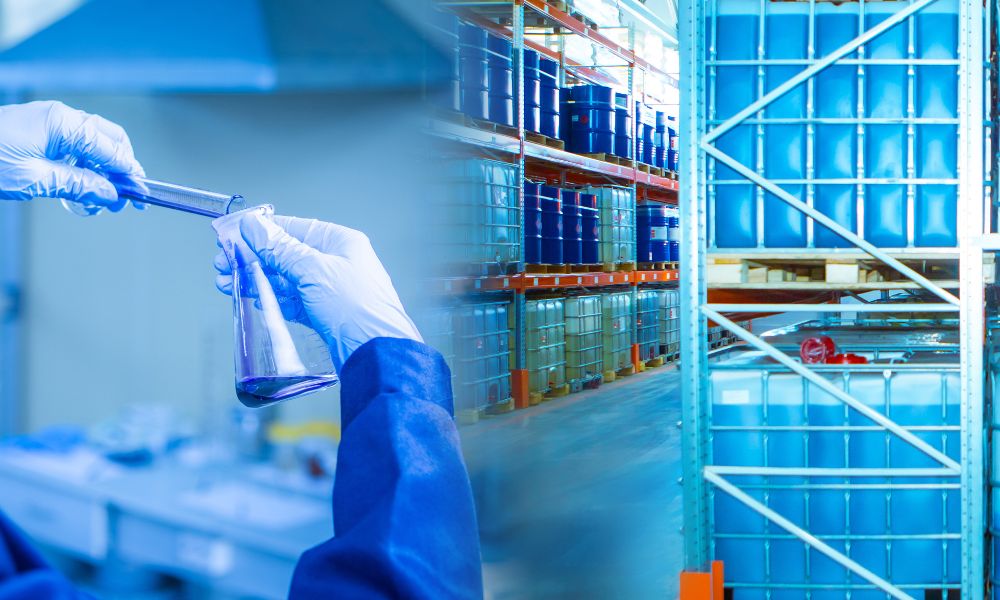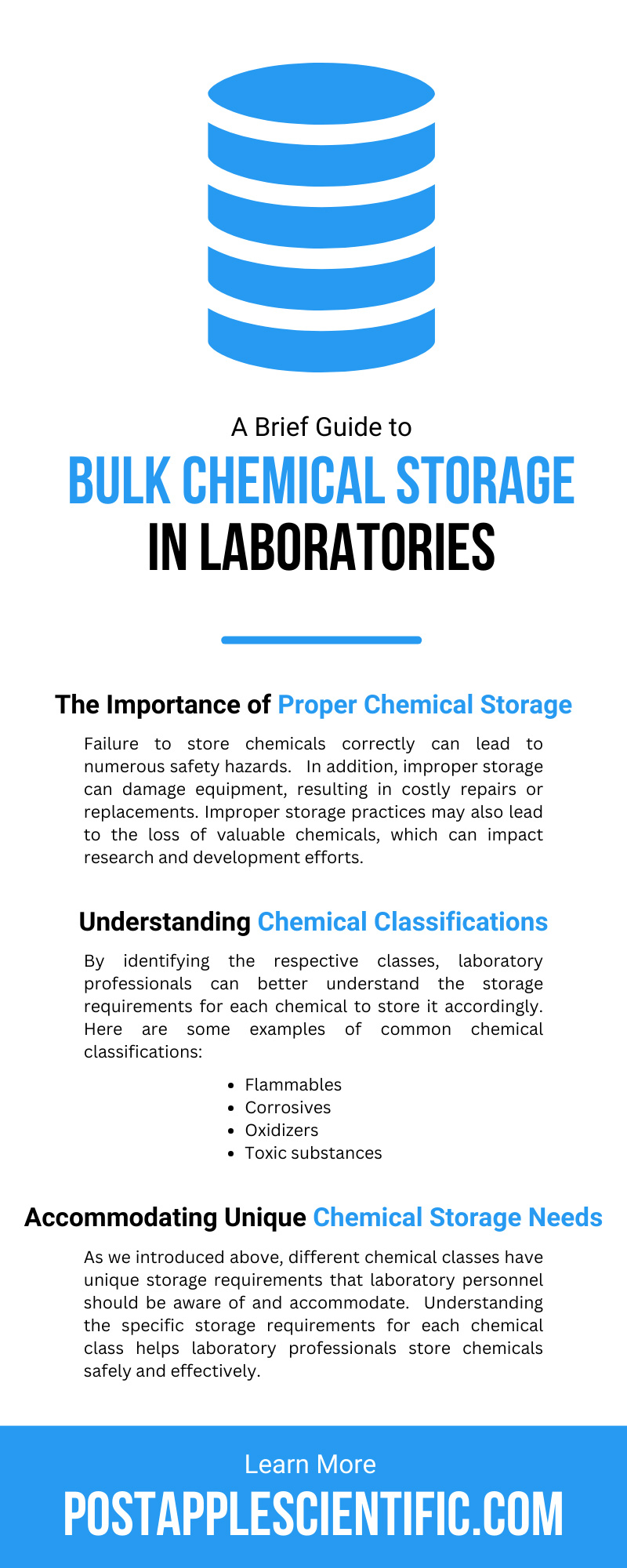Your cart is currently empty!
A Brief Guide to Bulk Chemical Storage in Laboratories

As a crucial aspect of laboratory safety and efficiency, proper storage of bulk chemicals is a topic that all current and aspiring laboratory professionals should understand. This brief guide to bulk chemical storage in laboratories will discuss the importance of proper storage, define chemical classifications, explore unique storage requirements, explain how to maintain chemical storage areas, and more. Following these guidelines will ensure the safety of laboratory professionals and students and contribute to a more organized and efficient workspace.
The Importance of Proper Chemical Storage
Failure to store chemicals correctly can lead to numerous safety hazards. For example, improper storage can result in chemical reactions, fires, explosions, and toxic releases that pose significant risks. In addition, improper storage can damage equipment, resulting in costly repairs or replacements. Improper storage practices may also lead to the loss of valuable chemicals, which can impact research and development efforts. Moreover, it can expose lab personnel to health risks, ranging from chemical exposure to inhaling toxic fumes.
Proper chemical storage promotes a safer working environment and safeguards chemical integrity, preserving chemicals’ effectiveness and usability. By implementing appropriate storage measures, lab professionals can minimize the risk of accidents, ensuring the well-being of all individuals involved.
Understanding Chemical Classifications
One of the first steps in organizing a laboratory is understanding the classification of chemicals. Each chemical belongs to a specific class, often based on hazard properties. By identifying the respective classes, laboratory professionals can better understand the storage requirements for each chemical to store it accordingly. Here are some examples of common chemical classifications:
- Flammables: These chemicals can easily ignite and burn rapidly in the presence of an ignition source, such as heat or a spark. Common examples of flammables include solvents such as ethanol and acetone. Laboratories should store flammables in fire-resistant cabinets away from ignition sources.
- Corrosives: Corrosive substances can damage or destroy living tissues and materials on contact. Acids like sulfuric acid and bases like sodium hydroxide are two common examples. Store corrosives in corrosion-resistant cabinets with secondary containment to prevent leaks and spills.
- Oxidizers: Oxidizing chemicals can provide oxygen, promoting the combustion of flammable materials. This makes them incompatible with flammable materials. Some examples are hydrogen peroxide and potassium permanganate. Store oxidizers away from flammables and other combustible materials in the lab.
- Toxic substances: Toxic substances have harmful effects on organisms when ingested, inhaled, or in contact with the skin. Examples include mercury and cyanide. These should remain in secure areas with adequate ventilation.
Understanding these classifications helps professionals determine the appropriate storage measures, thereby reducing potential hazards in the laboratory.
Accommodating Unique Chemical Storage Needs
As we introduced above, different chemical classes have unique storage requirements that laboratory personnel should be aware of and accommodate. For example, flammable chemicals require explosion-resistant storage cabinets or refrigerators designed specifically for flammable materials, while corrosive chemicals require storage in corrosion-resistant cabinets. Understanding the specific storage requirements for each chemical class helps laboratory professionals store chemicals safely and effectively.
General Guidelines for Chemical Storage
Laboratory professionals should follow several general guidelines when storing bulk chemicals. Following these guidelines helps maintain a safe laboratory environment and prevents potential hazards. Below are the chemical storage safety basics for your laboratory space.
Create Designated Chemical Storage Spaces
Designating specific storage spaces for each chemical class is crucial in maintaining an organized and highly efficient laboratory environment. Doing so makes it easier to access the right chemicals promptly, ensuring smooth workflow and reducing the risk of cross contamination. Moreover, segregating incompatible chemicals in separate storage areas adds an extra layer of safety, significantly minimizing the potential for dangerous reactions and enhancing lab safety protocols. Having designated areas for bulk laboratory chemicals also helps reduce the risk of exposure to protect your laboratory staff.
Label All Laboratory Chemicals
Proper labeling is an indispensable and crucial aspect of chemical storage in laboratories. Every container should have an accurate and legible label, providing comprehensive information about the chemical’s name, potential hazards, and necessary safety precautions. This meticulous labeling practice ensures that all laboratory personnel can readily identify the chemicals within and handle them safely, promoting a secure working environment and minimizing the risk of accidents or mishaps. When labeling, remember to sort chemicals alphabetically only once you have separated them by chemical class. By adhering to these labeling protocols, laboratories can effectively manage their chemical inventory and prioritize the safety of their personnel.
Store Chemicals by Compatibility
Storing chemicals based on their compatibility is crucial for preventing unwanted reactions and accidents. Store incompatible chemicals separately, ensuring sufficient distance or barriers between them. This precautionary measure minimizes the risk of mixing in case of spills or leaks, reducing the potential for hazardous situations. Additionally, all labs should consult the Safety Data Sheet (SDS) for specific guidelines on the appropriate storage of chemicals and their compatibility with other substances.
Maintain Chemical Storage Areas
Regular maintenance of chemical storage areas is of utmost importance to ensure a safe laboratory environment. Conduct frequent inventory checks to track chemical quantities, organize storage areas, and promptly identify any expired or damaged chemicals for proper disposal. Regularly inspecting storage facilities for signs of damage, leaks, and inadequate ventilation can help you promptly address issues that arise. By implementing and adhering to these diligent maintenance practices, laboratory professionals can rest assured that their chemical storage areas will remain safe and highly efficient in supporting their scientific endeavors.
Work With a Trusted Chemical Supplier
Another crucial aspect of chemical safety in the laboratory is working with a supplier you can trust. Choosing a trustworthy company will ensure that the chemicals you obtain are accurate to their names and listings and free of impurities. When choosing a scientific chemical supplier, make sure that it has positive ratings and testimonials and offers quality customer service. If you’re looking for a supplier for your own lab chemicals, contact Post Apple Scientific today for more information.
Proper bulk chemical storage is crucial for the safety, organization, and efficiency of laboratories. Understanding chemical classifications, accommodating unique storage requirements, following general guidelines, labeling chemicals accurately, and maintaining storage areas are all essential aspects to consider when storing chemicals in bulk. By following this brief guide to proper bulk chemical storage in laboratories, laboratory professionals can promote a safer and more efficient workspace for all personnel involved.

Leave a Reply